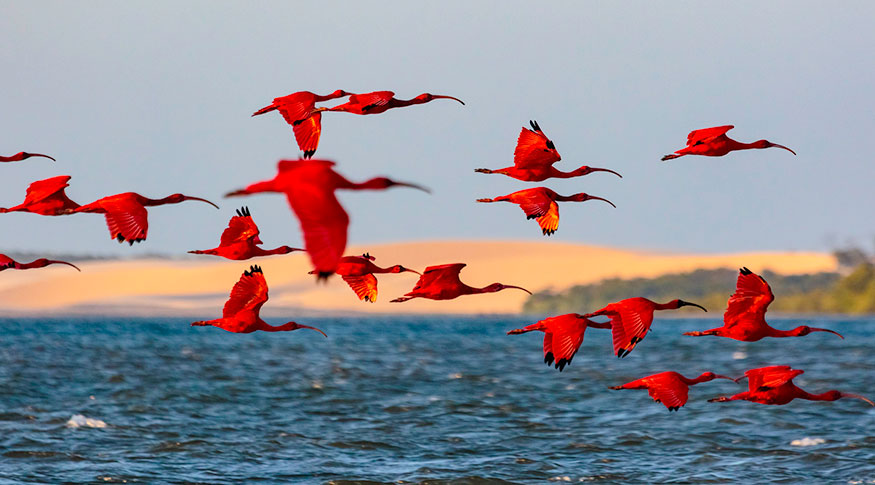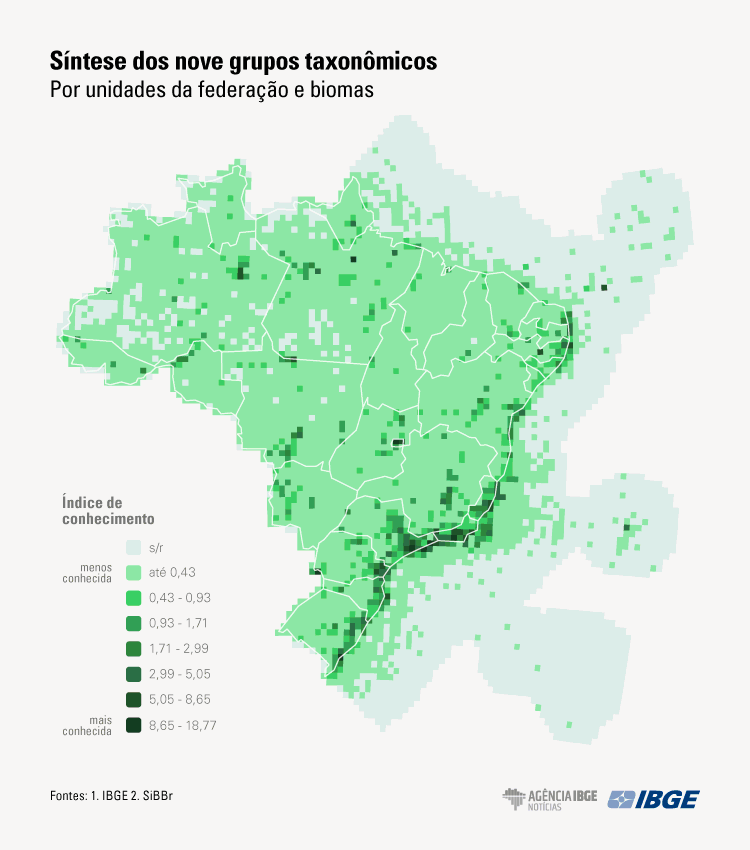Biodiversity
IBGE assesses data records on Brazilian biodiversity
November 23, 2023 10h00 AM | Last Updated: November 28, 2023 02h22 PM
Highlights
- IBGE releases assessment of data on Brazilian biodiversity available in the information System oo Brazilian Biodiversity (SiBBr) in 2022.
- The SiBBr is managed by the Ministry of Science, Technology an innovation (MCTI) and operated by the Brailian Network for Education and Research (RNP). It is part of the Global Biodiversity Information Facility (GBIF). The target public for this platform is mainly formed by researchers, students and governmental agencies.
- The material assessed encompasses more than 22.5 million records on fauna and flora occurrence, from different sources. The taxonomic groups analyzed were: amphibians, arthropods, birds, fungi, mammals, mollusks, bony fishes, vascular plants and reptiles.
- Indicators about the quantity, age and representativeness of records have been mapped all over the country. Except for birds, the number of records with complete information (including dates, geographic coordinates and identification of the species) is lower than 30%.
- Birds and plants stand out in terms of number of records and in their distribution among the different characteristics analyzed. Arthropods, mollusks and fungi are less represented.
- Among the categories, Biological Collections had the biggest number of publishers in the SiBBr. Citizen Science accounted for the biggest volume of registers.
- The main restraints found in data were the absence of geographic coordinates and the lack of detailed information for the identification of species. In spite of that, the proportion of more complex records has increased in the last few years.
- There was a great difference in the number of records between the Federation Units and geographic areas. There is a significant contrast in the quantity of se and terrestrial biodiversity records.
- About 81% of the marine cells and 6% of the terrestrial ones had no records.
- Most of the SiBBr registers are ten years of age or under, which reflects a trend to increase in the production of data. That is due, among other reasons, to the fact that data georeferencing has become a more accessible resource.

The IBGE released, today (23), an assessment of existing data on biodiversity in Brazil in 2022. The unprecedented study mapped, with a statistical grid, the records of fauna and flora occurrence from different sources, as part of the Information System on Brazilian Biodiversity (SiBBr). The taxonomic groups analyzed were amphibians, arthropods, birds, fungi, mammals, mollusks, bony fishes, vascular plants, and reptiles. Brazil is among the 17 countries that house more than 70% of the listed species on the planet, but there is still a lot to discover and catalogue.
Because this is an experimental investigation, improvements will be made considering the receptiveness of users. This publication is, therefore, an invitation to readers interested in this topic to share their perceptions, criticism, and suggestions with the IBGE, by submitting them to the Institute’s Customer Services.
The SiBBr, a platform of the federal government managed by the Ministry of Science, Technology and Innovation (MCTI), was created in 2014 with the objective of storing and making available information on Brazilian biodiversity and ecosystems. The tool provides material to public agencies aiming at conservation and sustainability. National education and research institutions, both public and private, research projects and programs and thematic networks are the main providers of data for the SiBBr.
The System is part of the Global Biodiversity Information Facility (GBIF), a multilateral initiative with approximately 60 countries. “there is a strong demand, inside and outside Brazil, for information on national biodiversity. The objective of the study was to evaluate the group of data available on the SibBr, with the identification of blanks and restraints of data. The IBGE has the mission of portraying Brazil, and biodiversity is a fundamental element of this portrait. Besides contributing to the SiBBr by means of the biological collections kept by the IBGE, we have also tried to advance in the production of statistics,” explains Leonardo Bergamini, Biodiversity analyst for the IBGE.
The assessment by institutions such as the IBGE is important for the SiBBr. It is a way of correcting problems and make improvements in the platform, by working on the quality of data,” adds Keila Juarez, a specialist on Biodiversity Information for the SiBBr.

Except for birds, the number of records with complete information is less than 30%
Data publishers were divided into four categories: Citizen Science (records published by a community of users), Biological Collections (repositories of organisms or samples organized for scientific purposes), Research Projects or Programs (results of scientific research) and Other (not fitting into any of the categories above).
In the analyzed groups, except for birds, the number of records with complete information does not reach 30% of the total available data. Birds and plants, groups more easily detected and collected, showed the highest number and better distribution of records, while arthropods, mollusks and fungi had a less representative sample.
Information from Biological Collections formed the most frequent publisher category on the SiBBr, followed by Projects and Others. The Citizen Science category concentrated the largest volume of records, especially of birds, even with only three publishers. The main limitations of the dataset are the absence of geographic coordinates and the lack of details in the identification of recorded species, but the proportion of more complete records has been increasing.
Differences in research infrastructure accentuate inequalities in scientific production
Regional disparities were observed in the density of records. Differences in research and documentation infrastructure, as well as the concentration of scientific institutions such as universities and museums are possible explanations. São Paulo, the Federal District and Rio de Janeiro were the Federation Units with the highest number of collections and records, as well as with the highest densities. The Northeastern states, on the other hand, had the lowest number of registers, and the Northern states showed the lowest densities.
There was a significant difference in the registers of sea cells compared to terrestrial cells, which are more studied and documented. Approximately 81% of the marine cells do not have a record of occurrence, while for the terrestrial cells this rate is about 6%. This difference is probably caused by a more difficult access and by higher operating costs of marine research.
Most of the existing records on the SiBBr are recent (up to 10 years). This is the result of an increase in data production in recent years and of the greater access to georeferencing technology .

Clara Fonseca, SiBBr's business analyst, emphasizes the importance of partnerships like the one between the IBGE and the SiBBr in disseminating knowledge about biodiversity in the country. "We need more people get to know about the SiBBr, so that the data can be used by society in public policies for the conservation of the environment. The more visibility the system gets, the greater the number of researchers encouraged to share their findings," she points out.
"There are many studies that evaluate databases, but most of them analyze specific groups. One of the differentials of this research is that we are working with the entire country, covering nine taxonomic groups, spatial and time-related information. Our intention is to identify the problems, understand what we have in our hands and what can be improved," says Mariza Pinheiro, IBGE's Biodiversity analyst.




















